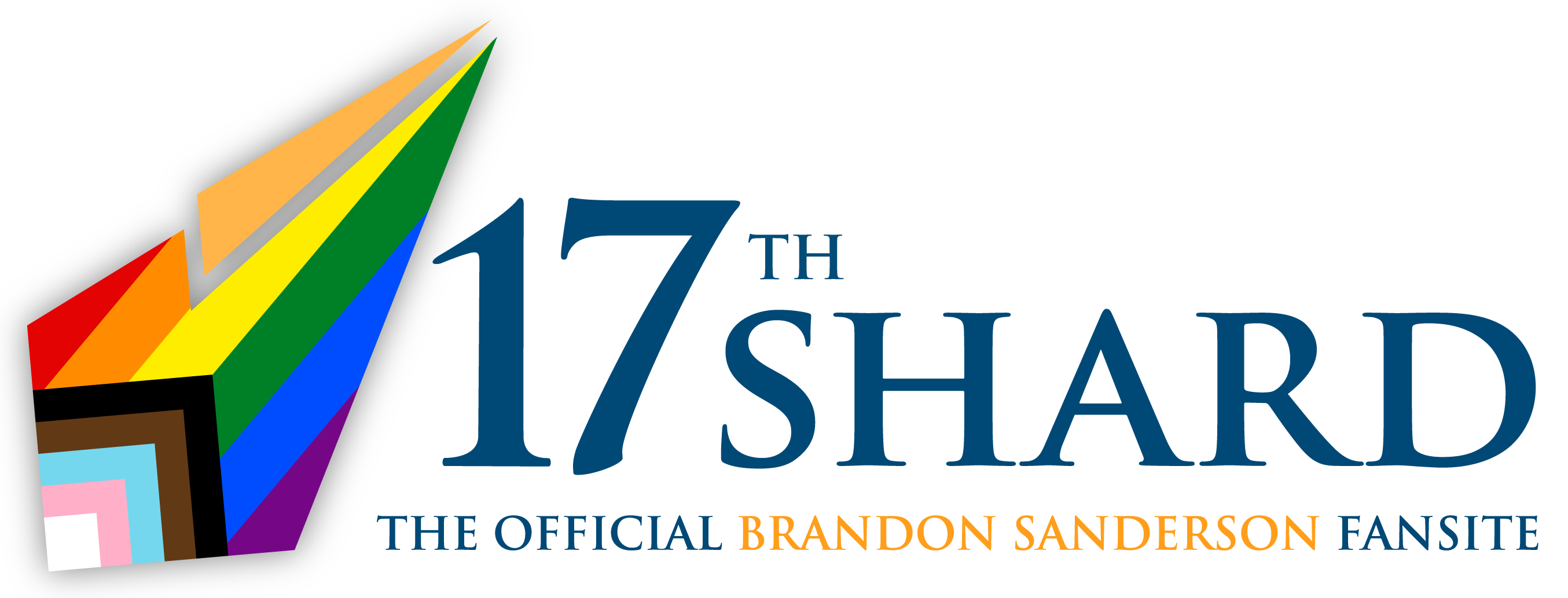Beautiful Destroyer: Depictions of Violence in the Cosmere

“Beautiful destroyer. Blunt and effective. Of all those I've claimed over this brief thousand years, you are the only one I think just might be able to understand me.”
-Ruin, Hero of Ages, ch. 57.
[CONTAINS OATHBRINGER SPOILERS]
I once listened to a speaker presenting on the story-telling potential of role-playing MMOs. The thesis was that, through the mechanics of the open-ended game play, the players became story-tellers, crafting unique collaborative narratives through the actions and interactions of their created characters. The presentation was very well done, and I was pleased to see alternative forms of story-telling (focusing on fantasy!) getting some of the spotlight. However, I wondered about the boundaries of this story-telling model: which stories were allowed in, and which were barred at the door?
“What about stories of non-violence?” I asked. While there were options available for those stories, blacksmiths or farmers, the presenter admitted that it would be difficult to advance in the games without violence of some kind, and the story-telling potential would thus be limited.
Violence is often a staple of fantasy. One of the escapist attractions of the genre is that feeling of power you feel when witnessing a character you identify with have a moment of awesome. While some of us may be martial arts experts or hardened soldiers in our daily lives, many of us are not, and reading about epic heroes laying waste to their evil enemies can be an empowering and gratifying experience for those of us with frustrations we are unable to take a fist or bolt of magical energy to. There's a reason The Emperor's Soul is about Shai, and not the simple life version of her that would be created if she used her final Essence Mark. One of the reasons we read fantasy is to see extraordinary characters doing amazing things.
It is important, however, to question the violence we see when reading. Is it realistic? What do these moments of awesome cost the characters? In my opinion, the cosmere books do a good job of providing diverse moments of awesome, unlike the MMOs from that presentation: Raoden reviving Elantris in a burst of light by scraping the chasm line into the ground, Sazed ascending and recreating the world with the knowledge in his metalminds, or Shallan discovering the secret of the Oathgates through scholarship and ingenuity. On the other hand, many moments of awesome in the cosmere are moments of great violence.
So where does this leave us as readers? Are we, like Re-Shephir, creatures “of instinct and curiosity, drawn to violence and pain like scavengers to the scent of blood” (Oathbringer, ch. 30)? I don't think so, and furthermore, I don't think Brandon wants his readers to be mere spectators of blood sport. In particular, Brandon's characterization of Vin and Dalinar, arguably the two most violent figures in the cosmere, displays a sensitive and nuanced approach to depicting violence, thrilling readers with incredible fights scenes, without glorifying killing and death. Awe and disgust may be opposites, but they are brought together in Vin and Dalinar: the beautiful destroyers.
The Mistborn Trilogy is known for its gorgeous fight scenes. Mistborn possess a grace that few cosmere killers can match. When Vin sets out with Zane to attack Cett, she doesn’t just go to make a dent in Cett’s forces. The killing is secondary, while Vin’s primary purpose is to awe Cett with her power:
The Well of Ascension, ch. 43 said:Zane was right. They didn’t just need to kill Cett. They needed to terrify his entire army.
Vin Pushed against the same corpse that Zane had thrown out the window, using its metal armor as an anchor. It shot down at an angle, passing just inside a broken window, and Vin soared upward in an angle away from the building. A quick Pull directed her back to the building once she reached the elevation she needed. She landed at a window on the fifth floor.
Vin grasped the stone sill, heart thumping, breaths coming in deep gasps. Sweat made her face cold in the winter breeze, despite the heat burning within her. She gulped, eyes wide, and flared her pewter.
Mistborn.
She shattered the window with a slap. The soldiers that waited beyond jumped backward, spinning. One wore a metal belt buckle. He died first. The other twenty barely knew how to react as the buckle buzzed through their ranks, twisting between Vin’s Pushes and Pulls. They had been trained, instructed, and perhaps even tested against Allomancers.
But they had never fought Vin.
Men screamed and fell, Vin ripping through their ranks with only the buckle as a weapon. Before the force of her pewter, tin, steel, and iron, the possible use of atium seemed an incredible waste. Even without it, she was a terrible weapon—one that, until this moment, even she hadn’t understood.
Mistborn.
The last man fell. Vin stood among them, feeling a numbing sense of satisfaction. She let the belt buckle slip from her fingers. It hit carpet.
While we see men screaming and falling in this scene, Vin captivates the majority of the reader’s attention. She is the “terrible weapon”, a Mistborn at the height of her power. Even without atium, in this scene, Vin demonstrates to Cett’s entire army that none can stand against her. In many ways, this should be a triumphant moment for Vin. After being trapped between two armies, fearful and paralyzed with indecision, in this scene she is unleashed and allowed to stretch her abilities to their full potential. And, after patiently waiting for this moment, it is difficult not to be in awe of her.
But at what cost?
After decimating Cett’s forces, Vin comes across Cett and his son, one of whom she is convinced is Mistborn.
The Well of Ascension, ch. 43 said:Vin turned toward the nobleman. She remembered her frustration, her rage, her cool, icy anger. She stepped forward and grabbed Cett by the front of his suit. “Fight me,” she said, and tossed him backward.
He slammed against the back wall, then slumped to the ground. Vin prepared her atium, but he did not rise. He simply rolled to the side, coughing.
Vin walked over, pulling him up by one arm. He balled a fist, trying to strike her, but he was pathetically weak. She let the blows bounce off her side.
“Fight me,” she commanded, tossing him to the side. He tumbled across the floor—head hitting hard—and came to rest against the burning wall, a trickle of blood running from his brow. He didn’t rise.
Vin gritted her teeth, striding forward.
“Leave him alone!” The boy, Gneorndin, stumbled in front of Cett, raising his dueling cane in a wavering hand.
Vin paused, cocking her head. The boy’s brow was streaked with sweat, and he was unsteady on his feet. She looked into his eyes, and saw absolute terror therein. This boy was no Mistborn. Yet, he held his ground. Pathetically, hopelessly, he stood before the body of the fallen Cett.
“Step aside, son,” Cett said in a tired voice. “There is nothing you can do here.”
The boy started to shake, then began to weep.
Tears, Vin thought, feeling an oddly surreal feeling cloud her mind. She reached up, surprised to find wet streaks on her own cheeks.
“You have no Mistborn,” she whispered.
Vin seeks to solve her problems with Cett through violence, but when she finally reaches him, she finds she cannot. Though she commands him to fight her, neither Cett nor his son, Gneorndin, can respond to her challenge. Brandon excites us by setting Vin loose to use her powers, but even the incredible, dazzling violence Vin unleashes is not an answer to her problems.
The next morning, when Elend finds Vin, she is consumed with regret, confessing that while her old crew leader, Camon, was brutal and terrible, she likely killed more people in a single night than he had in his entire life. She goes on to say: “My entire life has been death, Elend. Death of my sister, the death of Reen. Crewmembers dead around me, Kelsier falling to the Lord Ruler, then my own spear in the Lord Ruler’s chest. I try to protect, and tell myself that I’m escaping it all. And then…I do something like I did last night” (The Well of Ascension, ch. 44).
Following her massacre, Vin struggles to come to terms with being both surviving and causing great violence. This personal conflict is eventually resolved in Hero of Ages, when Vin uses the power of Preservation to destroy herself and Ruin, but along the way Brandon is careful to remind his readers of the human cost associated with his awesome fight scenes, both for the victims, and for the destroyer herself.
Brandon continues his discussion of the relationship between beauty and destruction in Oathbringer. Like Vin, violence gives Dalinar a sense of purpose:
Oathbringer, ch. 26 said:In moments like this, he could see why he had been created. He was wasted listening to men blab. He was wasted doing anything but this: providing the ultimate test of men's abilities, proving them, demanding their lives at the edge of a sword. He went them to the Tranquiline Halls primed and ready to fight.
He was not a man. He was judgement.
Enthralled, he cut down foe after foe, sensing a strange rhythm to the fighting, as if the blows of his sword needed to fall to the dictates of some unseen beat
Dalinar, and the reader along with him, fall under the Nergaoul’’s seductive spell. This moment is one of many where Dalinar is described as being more than a man. Here, he is judgement, sent by the Almighty to test the skill and worthiness of his enemies. While fighting with Blade and Plate might lack some of the otherworldly elegance of Mistborn or Windrunners, Dalinar’s fight scenes in Oathbringer remain captivating, even in their brutality. After hearing about the might and power of the Blackthorn in his prime, the reader is encouraged here to indulge as they enjoy watching Dalinar be awesome (sorry Lift, but you can’t hog it all to yourself).
The way Brandon describes Dalinar in these fight scenes resembles how he describes Vin: both come to think of themselves as concepts or roles, rather than as individual people: Vin as Mistborn, and Dalinar as judgement.
And yet, even the Blackthorn, who, despite his later redemption is likely the most brutal character in the cosmere, retains enough humanity to recognize the horror of what he is doing:
Oathbringer, ch. 26 said:The dead. Hundreds upon hundreds of them, with shriveled coals for eyes, their armor and weapons sheared but their bodies eerily untouched. Almighty above . . . how many had he killed?
[. . .]
Dalinar grinned in satisfaction, then grew chill. A few of those bodies with burned eyes--three men he could spot--wore blue. His own men, bearing the armband of the Elites.
Dalinar’s Shards and incredible fighting skills give him great power to defeat his enemies, but Brandon is quick to point out that there is a cost to getting lost in the glory of battle by emphasizing the destruction Dalinar has caused, and by highlighting that some of Dalinar’s own men also fell to his onslaught.
After defeating the enemy general, Kalanor, Dalinar struggles to feel satisfied with his victory:
Oathbringer, ch. 26 said:It had been a fine fight. He’d accomplished what he’d wanted. He’d conquered all who stood before him.
And yet he felt empty. A voice within him kept saying, “That’s it? Weren’t we promised more?
It is this voice which drives Dalinar to continue his killing spree beyond what is necessary to win the battle. He wonders, “Shouldn’t the strongest rule? Why should he sit back so often, listening to men chat instead of war?” (Oathbringer, ch. 26). It is only after the Thrill almost drives Dalinar to kill his brother Gavilar that Dalinar stops and realizes what he has done. Gavilar’s celebration of Dalinar’s great victory is undermined by Dalinar’s feelings of guilt and shame for almost killing his brother. Despite Dalinar’s aptitude for war and fighting, and his oft emphasized disdain for conversation and politics, his great skill and power are not enough to satisfy him.
Like Vin, Dalinar’s power and might leave him unfulfilled and unable to solve his problems. When he finally remembers burning the Rift, the voices of Evi and the children he killed haunt him: “Hypocrite, they said. Murderer. Destroyer” (Oathbringer, ch. 100). As he remembers his past, the actions that made Dalinar a fearsome warrior are a source of torment, rather than triumph, for him. Throughout Oathbringer, Dalinar often remarks about how difficult it is to adjust his thinking and unify people with politics and persuasion rather than by brute force, and how ill suited he is to the task of brokering peace.
Both Hero of Ages and Oathbringer end with their respective destroyers overcoming inner turmoil to find some measure of self-acceptance. Vin determines that she can destroy to protect and is able to use Preservation in a way Leras never could. In doing so, she overcomes destruction incarnate by defeating Ruin, arguably the greatest destroyer the in the cosmere.
Faced with a seemingly unstoppable force in Odium and the Fused, Brandon makes the reader think Dalinar may succumb to his past of destruction and violence and become that which he set out to defeat: Odium’s Champion. Armed with a book and, more importantly, the convictions it has taught him, Dalinar refuses to be a destroyer any longer. While Vin conquers destruction, she does so through continued violence. With Dalinar, Brandon takes his examination of violence further. Despite all of the breath-taking fight scenes in Oathbringer, the most awe-inspiring scene in the novel, and the crux of the epic climax, is the moment Dalinar, surrounded by gloryspren, refuses to give Odium his pain and opens the perpendicularity. In that moment, Daliner bests Odium, not with force, but by taking responsibility for his actions.
Similarly, Dalinar overcomes Nergaoul with understanding, rather than a contest of force:
Oathbringer, ch. 120 said:Dalinar’s entire life had been a competition: a struggle from one conquest to the next. He accepted what he had done. It would always be part of him. And though he was determined to resist, he would not cast aside what he had learned. That very thirst for the struggle—the fight, the victory—had also prepared him to refuse Odium.
“Thank you,” he whispered again to the Thrill, “for giving me strength when I needed it.”
The Thrill churned close around him, cooing and exulting in his praise.
“Now, old friend, it is time to rest.”
While his history of struggle and violence is what allows Dalinar to capture Nergaoul, the capture itself, and the subsequent defeat of Odium’s forces, does not come about through violence on Dalinar’s part. Instead, Dalinar embraces the Thrill, thanking it for what it did for him in the past, and drawing it in close. He convinces it to rest in the gemstone. Like Vin overcoming Ruin, in this scene Dalinar, the destroyer, overcomes a divine force of destruction in a captivating way, but he does it without resorting to violence himself.
In both Vin and Dalinar, Brandon sets out heroes who struggle with their self definition in the face of the violence they have committed against others. Brandon juxtaposes the hauntingly beautiful action sequences against the emotional impact those acts of violence have on the human soul, allowing his readers to enjoy the display while still being critical of that enjoyment. In their greatest moments, Brandon shows Vin and Dalinar overcoming violence and destruction, despite their status as destroyers, demonstrating that the ‘moments of awesome’ fantasy is known for do not always need to be violent ones, and that the beauty of destruction comes at a cost.
_________
Post Script: As it turns out, Brandon himself has commented on the concept of beautiful but terrible violence in the Well of Ascension Annotations. Unfortunately, I did not find this quote until after I finished the essay above, but it has probably been bouncing around in the back of my head since I originally read it way back when. Enjoy Brandon’s take on the violence in Well of Ascension:
Brandon Sanderson said:Brandon Sanderson
Vin Assaults Cett's Keep
This is one of my favorite chapters in the book. I only occasionally REALLY let myself go with Allomancy, letting the Mistborn reach for their potential. I don't like violence. And yet, I love the beauty of a good fight.
This is a twisted beauty. Corrupt, fascinating, destructive—yet powerful. I've wanted to write something like this ever since I saw the lobby scene in the Matrix. Not because it was so amazing—which it was—but because I think they handled it wrong. The characters commit this huge slaughter, but we never see the horror of it—only the awesome visuals.
There are repercussions for doing something like what happens in this chapter. Perhaps Zane can slaughter wantonly, but that's only because he's beaten his conscience away repeatedly. Vin will not escape so easily.
Oh, and the guy on the wall—Wells—is a cameo. He is my good friend, Dan Wells. He's not this much of a coward, but he didn't make it into book one, so I figured I'd throw him in here. He'll be back, actually. . . . (Watch for him in Book Three.)
Image Credit: "Vin in the Mists" by Xenia de Vries. You can also find her work on Instagram! Used with permission.



Recommended Comments
Join the conversation
You can post now and register later. If you have an account, sign in now to post with your account.